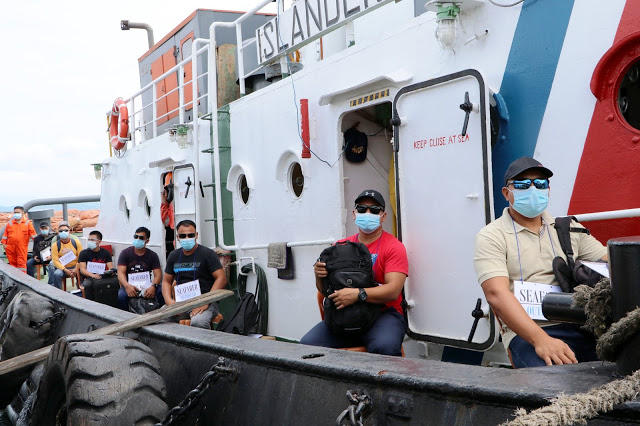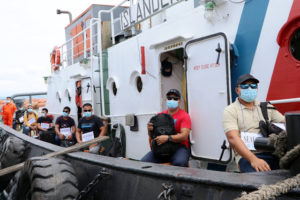

The ports of Manila, Subic in Zambales and Capinpin in Bataan have been activated as Philippine hubs for crew change as the country seeks to establish itself as a crew change capital of the world.
This is part of a project that seeks to facilitate the speedy and safe travel of seafarers and change of crew during the coronavirus disease (COVID-19) pandemic.
Port Capinpin in Bataan on August 19 joined the Port of Manila as a crew change hub, while Subic port was formally activated on August 22. Other ports set for activation include Batangas, Davao, and Cebu, according to the Department of Transportation (DOTr).
The Inter-Agency Task Force for the Management of Emerging Infectious Diseases (IATF) had earlier approved DOTr’s proposal to dedicate Subic port and other ports nationwide as hubs for international crew change.
READ: Subic designated hub for international crew change
The Philippines is one of 13 countries which earlier committed to the International Maritime Organization (IMO) to facilitate crew changes and achieve key worker designation for seafarers.
IMO noted this “represents significant progress to help resolve a growing crisis facing the maritime industry, and enable hundreds of thousands of stranded seafarers to go home or join ships.”
In a joint statement, representatives from 13 countries expressed deep concern about the current manpower crisis. They acknowledged that “the inability of ship operators worldwide to conduct ship’s crew changes is the single most pressing maritime operational challenge to the safe and efficient movement of global trade.”
DOTr noted that crew change is essential to seafarers’ safety, health, welfare and employment as they can only serve on board a vessel without leave for a maximum of 11 months based on the International Labour Organization 2006 Maritime Labour Convention (MLC).
It added that ships around the world are operated by around 1.5 million seafarers, of which 378,000 or 25% are Filipinos.
“To guarantee that the health and safety of seafarers and the public are protected while we work on this endeavor, the DOTr and its attached agencies are activating hubs in close coordination with various government agencies and units involved in crew changes,” officer-in-charge Transport assistant secretary for maritime Narciso Vingson, Jr.
Office of Transportation Security (OTS) undersecretary Raul Del Rosario said Subic Bay is strategically located for crew changes due to its proximity to countries with high trading activities.
With an active maritime industry, excellent port facilities and safe harbor, Subic Bay can offer everything shipping principals are looking for in a crew change hub, he continued.
A One-Stop Shop (OSS) has also been established to ensure that the health requirements are met, he added.
The crew change hub abides by established health and quarantine protocols of the Department of Health (DOH), according to Philippine Coast Guard Commandant George Ursabia, Jr.
“To ensure the smooth flow of operations, we have conducted a dry run which was witnessed by the public,” Ursabia said.
Meanwhile, MARINA administrator Robert Empedrad underscored the need to establish crew change hubs in the country especially during the pandemic.
Seafarers of all nationalities are already experiencing immense physical and mental fatigue brought on by overstaying onboard ships at sea, and if this is allowed to continue, it could affect delivery of essential cargo, Empedrad said.
“Having crew change hubs in the country will solve this problem and give our seafarers the advantage of swift processing due to the established protocols,” he said.
Aside from facilitating the transfer of stranded marine personnel off their vessels, crew change hubs in the country can also generate economic activities and revenues in local areas through the collection of port dues and charges from ship dockage or anchorage, Philippine Ports Authority (PPA) general manager Jay Daniel Santiago stated.
“By becoming a crew change capital of the world, we would not only prime up our seafaring and maritime industry. We also expect to boost our hospitality industry,” Santiago said.
In the last four months, a total of 734 ships had docked or anchored in the Port of Manila for crew change. A total of 34,000 seafarers were served, wherein 28,000 seafarers disembarked while 5,800 joined the ships.
For ship turnaround, cargo ships usually stay for about 6 to 12 hours while cruise ships stay for a week up to a month if they serve as quarantine facilities.
“We can look forward to the same maritime traffic in other hubs as more foreign shipping principals are expected to patronize our ports for crew change,” Santiago said.
He added that aside from opening Philippine ports for crew change, the Joint Circular for Green Lane for seafarers provides for the speedy movements of seafarers in the country.
“Three major shipping companies of Japan already bannered our green lane program in the conduct of crew change. We expect other flags to follow their lead,” he said.




